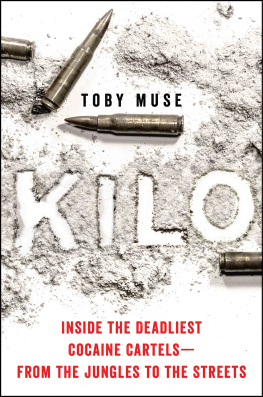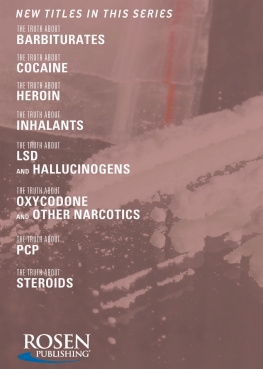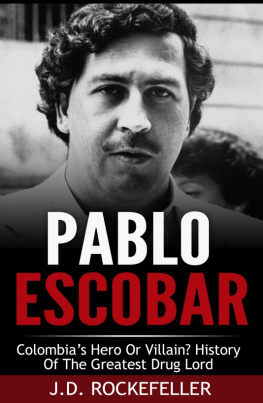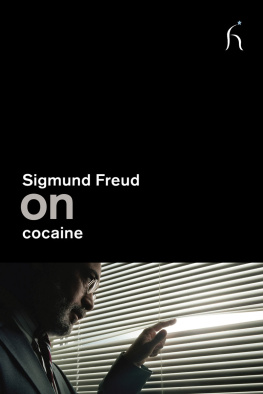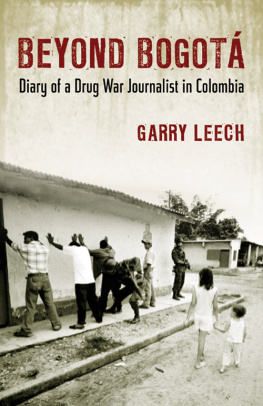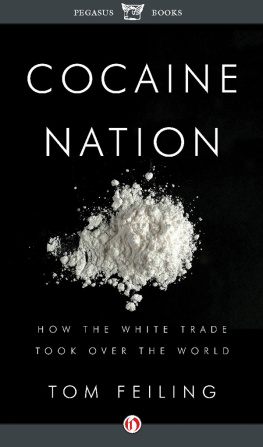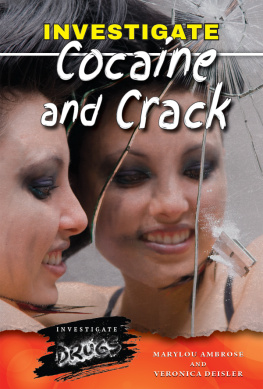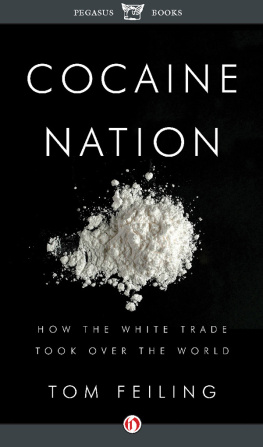Contents
Guide
To my mum, who pushed me to start this book.
To Monica, for helping me finish it.
Contents
Names have been changed throughout this book for the safety of some. Those of the underworld agreed to be interviewed on the condition that their names werent used and identifying details were removed.
PEACE! PEACE! PEACE!
You couldnt walk anywhere without tripping over the word. It was all people spoke of, all they thought of. That this wonderful word peace was on the lips and minds of men and women carrying AK-47s, terrorists in the eyes of the world... well, that was beautiful! Half a centurys worth of fighting was about to come to a glorious end, something that many of us in Colombia never thought we would see.
And yet here we were, gathered in the middle of Colombias nowhere, as the FARC, the Revolutionary Armed Forces of Colombia, held its Tenth Conference. More than two thousand guerrillas had marched for weeks, AK-47s slung over their shoulders, across misty mountaintops and wet jungles to get here. The comrades had come to vote on whether to accept a peace deal with the Colombian state.
The FARC was the biggest, deadliest rebel army in the Americas. Battle-tough, theyd been fighting the Colombian state, US spies, and military advisors for more than five decades, the worlds longest-running insurgency. Their goal: a violent revolution to install a Marxist-Leninist dictatorship of the proletariat. The civil war had killed more than 200,000 people. And the rebels had been mainly funded by the cocaine industry.
FARC negotiators had spent four years quibbling every comma, period, and word of a 297-page document with a government team. The result? A blueprint for a new Colombia, a long-needed peace deal, investing in the countryside, education, social policies, building roads and bridges. (That the state needed pressure from violent insurgents just to provide basic services shows how abandoned parts of rural Colombia have been.) And central to this vision was a plan to end the cocaine industry, the root of so much of Colombias devastation.
For years, the FARC had been one of the key figures in Colombias massive cocaine industry, doing business with farmers cultivating the crops as well as with cartels and traffickers who were exporting it. Theyd used the hundreds of millions to grow and expand their bloody mission of violent revolution. In return for the money, the FARC had protected the fields of coca, the bushes that are turned into cocaine. This deal would put an end to all that. With the FARC out of the cocaine business, Colombia would have a once-in-a-lifetime chance to eradicate coca from the country, ending the drug business that has haunted Colombia for the past four decades.
Now hundreds of reporters from across the world were here to watch and see what the rebels would do. If the rebels voted yes, theyd lay down their weapons. They would become civilians, ending a war their grandfathers had started. Vote no? Another generation will know war.
I was one of the journalists, here in the hopes of seeing my adopted home grasp its chance at peace. I had reported on the never-ending wars of Colombias cocaine industry for fifteen years, making and losing friends in the bloodshed. Id seen too many seduced and corrupted by cocaine, too many slum kids die pointless deaths, too many driven mad by the violence. This peace deal, I hoped, could begin to end the cocaine industry here. I wasnt alone.
Millions watched with the same hopes. These rebels couldnt let us down. Colombia deserved peace. And thats the history we all felt in the air. The earth told you: take a moment, breathe it in, this is history unfolding before your eyes.
THE CONFERENCE WAS TO LAST ten days and was held in the Plains of Yari. Its about 190 miles from the capital, but its a hard twenty-four-hour drive through cloudy mountain passes and tracks so muddy they swallow motorbikes. The guerrillas had set up six camps for the thousands of guerrillas in the jungle that surrounded the open plains. They built cambuches, skeletal wooden huts, black plastic sheets providing the roofs. Beds were raised so the countless snakes wouldnt climb in searching for human warmth in the misty mornings. Men, women, we all bathed in the dark waters of the cool river.
An army of rebels built large tents, where after debating the peace process in the day, we drank beers, the rebels always with their automatic rifles and in their camouflage uniforms. Journalists took selfies with the top rebel commanders, as famous as pop stars in Colombia. The top guerrillas each carried $5 million bounties on their heads, offered by the State Department. Many were wanted in US courts for cocaine trafficking and kidnapping of US citizens. But here they drank beers and cracked jokes, confident in their reign of the wilderness. Above us hung huge banners of the FARCs logo: two AK-47s crossed beneath an open book (symbolizing the guerrillas dedication to violent revolution and their self-education).
It was a time to meet old acquaintances from the battlefield. In years past, women and men of the FARCs Sixth Front rained mortars down on me and civilians. The Eighteenth Front treated me as a guest of honor in secret rebel camps as we dodged army patrols and attack helicopters. The guerrilla known as Kunta Kinte who once told me: If you want to see weird stuff, go to war. You see strange things in war.
A guerrilla sat down next to me. Her eyes big and dark, her long black hair flowed from under a red beret with a patch of Che Guevara. Like all rebels, she was trained to start shooting at any moment. The FARC was one of the only rebel groups to let women fight on the front line. She laid her AK-47 across her lap and sipped her beer. On her nails were painted little Colombian flags, the red, blue, and yellow. She had the guerrillas dignity, her head held high.
Can you tell me... what does peace feel like? How do you live... in peace?
Peace! Its obvious, isnt it? Its the absence of war. Then I thought of when people ask me: Whats war like? Its more than just the absence of peace.
She looked to be twenty-five. She had only ever known war; the terror, the hatred, the frenzy of combat. All of Colombia would have to learn peace. Hundreds of thousands died in this war. Millions fled. It made Colombia the kidnap capital of the world. Worst human rights landscape in the Western Hemisphere. For what? A war that long ago lost any honor or reason.
The Plains of Yari itself had been the site of decades of war. Soldiers, rebels, death squads, cocaine cartels: they all had killed and buried their dead on these plains of jungle and empty spaces.
Each night huge salsa concerts blared out from a massive stadium-like stage constructed by the rebels. Beneath flashing red and blue lights, we danced with the rebels. Even in their camouflage uniforms and dancing in knee-high rubber boots, the guerrillas spun and twirled in grace.
Rebels looked at each other with eyes of love and sex. We baptized the conference FARCstock. Later, there would be a bumper harvest of babiespeace babies, theyll call them. A new country was to be born. Yes, there would be problems, but anthills compared to what had been survived already. The feeling was new, something here that Id never seen in Colombia: optimism. Planning for a beautiful future. Counting on the good.
And the peace process was already paying offa cease-fire between the FARC and the government had seen deaths related to the civil war fall close to zero. The military hospital was almost empty; admissions had fallen by 97 percent over five years.
And South America needed good news, a continent stagnated. Next door Venezuela was imploding, a once oil-rich country sunk by mismanagement and corruption. Its people hungered and died in the absence of basic medicine. Millions would literally walk out of the country, searching for a better life here in Colombia.
Next page
